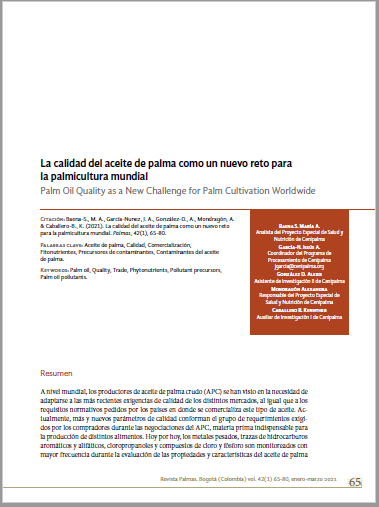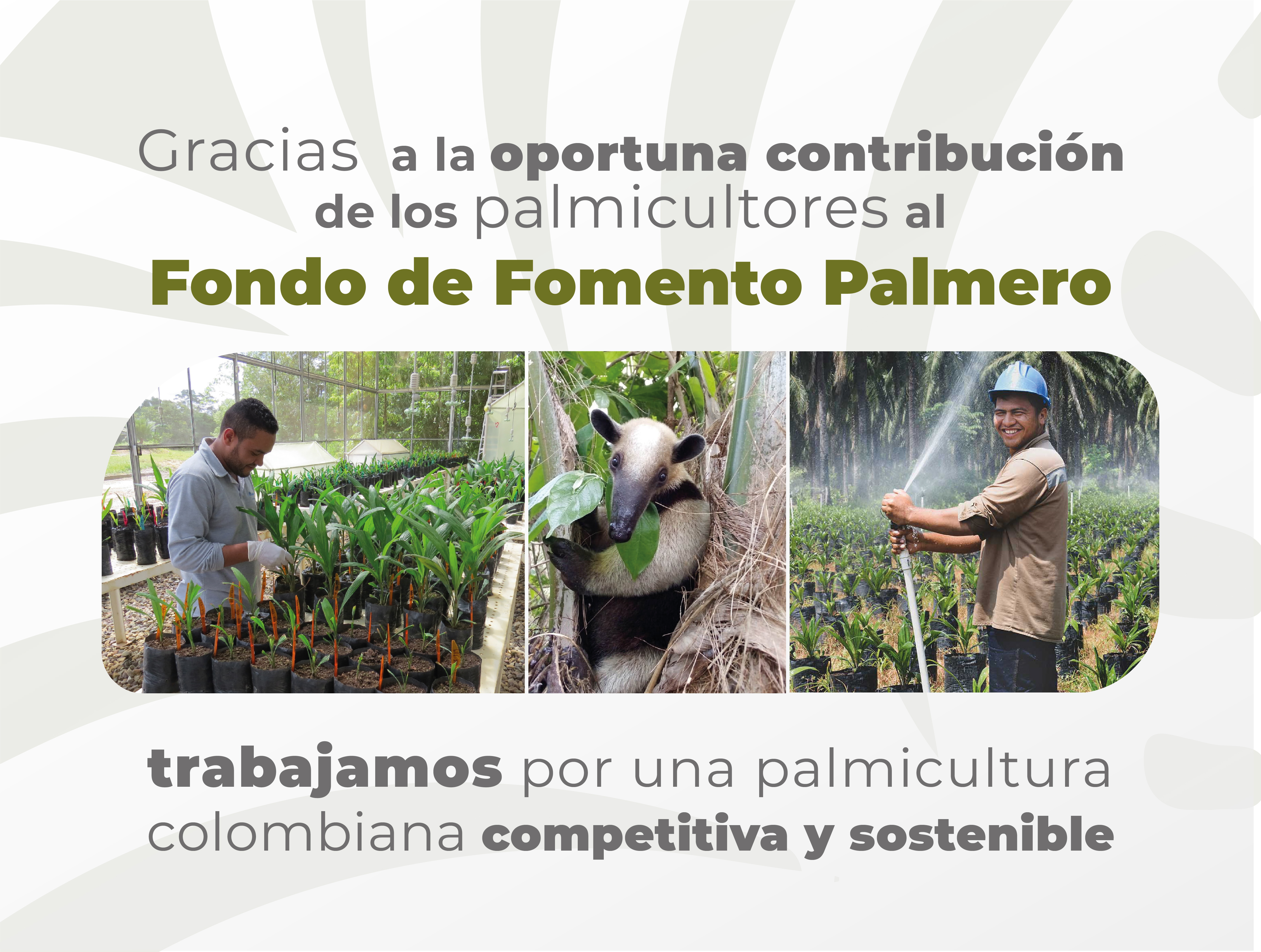La calidad del aceite de palma como un nuevo reto para la palmicultura mundial
Palabras clave:
Calidad del aceite de palma crudo, Composición del APC, Antioxidantes, Compuestos contaminantesResumen
A nivel mundial, los productores de aceite de palma crudo (APC) se han visto en la necesidad de adaptarse a las más recientes exigencias de calidad de los distintos mercados, al igual que a los requisitos normativos pedidos por los países en donde se comercializa este tipo de aceite. Actualmente, más y nuevos parámetros de calidad conforman el grupo de requerimientos exigidos por los compradores durante las negociaciones del APC, materia prim a indispensable para la producción de distintos alimentos. Hoy por hoy, los metales pesados, trazas de hidrocarburos aromáticos y alifáticos, cloropropanoles y compuestos de cloro y fósforo son monitoreados con mayor frecuencia durante la evaluación de las propiedades y características del aceite de palma crudo y refinado para su comercialización. Adicional a estos parámetros de calidad, es necesario tener en cuenta los que comúnmente se utilizan como el contenido de ácidos grasos libres (AGL), el índice de deterioro de la blanqueabilidad (DOBI) y la humedad e impurezas. En la actualidad, se trabaja de manera exhaustiva en la búsqueda de buenas prácticas de cultivo, procesamiento y refinación que garanticen la reducción de compuestos contaminantes del APC y de los precursores de contaminantes para los aceites refinados. De otro lado, el APC tiene una gran cantidad de compuestos menores con alto potencial nutricional y la capacidad
de generar elementos de alto valor agregado que no han sido debidamente utilizados. El objetivo del presente artículo es dar a conocer parte de las características que atribuyen valor nutricional al aceite de palma y los nuevos retos que enfrenta el sector palmero en lo referente a la presencia y disminución de precursores de contaminantes y de contaminantes formados durante la producción del aceite de palma, asimismo, pretende resaltar las prácticas que han dado buenos resultados en la mitigación de estos compuestos.
Referencias bibliográficas
Barrera, C., Hamner, H. C., Perrine, C. G. & Scanlon, K. S. (2014). National Health and Nutrition Examination Survey. Encyclopedia of Human Services and Diversity, 118(3), 464-470. doi: 10.4135/9781483346663.n401
Bennett, L. L., Rojas, S. & Seefeldt, T. (2012). Role of Antioxidants in the Prevention of Cancer. Journal of Experimental and Clinical Medicine, 4(4), 215-222. doi: 10.1016/j.jecm.2012.06.001
Buddhan, S., Sivakumar, R., Dhandapani, N., Ganesan, B. & Anandan, R. (2007). Protective Effect of Detary Squalene Supplementation on Mitochondrial Function in Liver of Aged Rats. Prostaglandins Leukotrienes and Essential Fatty Acids, 76(6), 349-355. doi: 10.1016/j.plefa.2007.05.00
Chang, A. S., Sherazi, S. T. H., Kandhro, A. A., Mahesar, S. A., Chang, F., Shah, S. N., Laghari, Z. H. & Panhwar, T. (2016). Characterization of Palm Fatty Acid Distillate of Different Oil Processing Industries of Pakistan. Journal of Oleo Science, 65(11), 897-901. doi:10.5650/jos.ess16073
Chaves, G., Ligarreto-Moreno, G. A. & Cayon-Salinas, D. G. (2018). Physicochemical Characterization of Bunches from American Oil Palm (Elaeis oleifera H.B.K. Cortes) and their Hybrids with African Oil Palm (Elaeis guineensis Jacq.). Acta Agronómica, 67(1), 168-176. doi: 10.15446/acag.v67n1.62028
Chew, C. L., Ab Karim, N. A., Kong, P. S., Tang, S. Y. & Chan, E.-S. (2021). A Sustainable In situ Treatment Method to Improve the Quality of Crude Palm Oil by Repurposing Treated Aerobic Liquor. Food and Bioprocess Technology. doi: 10.1007/s11947-021-02582-6
Chew, S. C., Tan, C. H., Pui, L. P., Chong, P. N., Gunasekaran, B. & Lin, N. K. (2019). Encapsulation Technologies: A Tool for Functional Foods Development. International Journal of Innovative Technology and Exploring Engineering, 8(5s), 154-160.
Chinenye, C. (2020). Storage Oxidation Stability of Crude Palm Oil with some Traditional Nigerian Spices. IOSR Journal of Environmental Science, 14(August), 1-09. doi: 10.9790/2402-1408020109
Code of Practice for the Reduction of 3-monochloropropane-1,2- diol esters (3-MCPDEs) and Glycidyl Esters (GEs) in Refined Oils and Food Products Made with Refined Oils, 6 (2019). Recuperado de https: www.fao.org/fao-who-codexalimentarius/sh-proxy/en/?lnk=1&url=https%253A%252F%252Fworkspace.fao.org%252Fsites%252Fcodex%252FStandards%252FCXC%2B79-2019%252FCXC_079e.pdf
Dian, N. L. H. M., Hamid, R. A., Kanagaratnam, S., Isa, W. R. A., Hassim, N. A. M., Ismail, N. H., Omar, Z. & Sahri, M. M. (2017). Palm oil and Palm Kernel Oil: Versatile Ingredients for Food Applications. Journal of Oil Palm Research, 29(4), 487-511. doi: 10.21894/jopr.2017.00014
Dutta, A. & Dutta, S. K. (2003). Vitamin E and its Role in the Prevention of Atherosclerosis and Carcinogenesis: A review. Journal of the American College of Nutrition, 22(4), 258-268. doi: 10.1080/07315724.2003.10719302
Estiasih, T. & Ahmadi, K. (2018). Bioactive Compounds from Palm Fatty Acid Distillate and Crude Palm Oil. IOP Conference Series: Earth and Environmental Science, 131(1). doi: 10.1088/1755-1315/131/1/012016
FAO, OPS, WFP & UNICEF. (2019). Panorama de la seguridad alimentaria y nutricional en América Latina y el Caribe 2019. Hacia entornos alimentarios más saludables que hagan frente a todas las formas de malnutrición. En Panorama de la seguridad alimentaria y nutricional en América Latina y el Caribe 2019.
Fedepalma. (2019). Anuario estadístico 2019. Principales cifras de la agroindustria de la palma de aceite en Colombia y en el mundo.
Fedepalma. (2020). Anuario estadístico 2020. Principales cifras de la agroindustria de la palma de aceite en Colombia y en el mundo. 238.
Gesteiro, E., Galera-Gordo, J. & González-Gross, M. (2018). Palm Oil and Cardiovascular Health: Considerations to Evaluate the Literature Critically. Nutrición Hospitalaria, 35(5), 1229-1242. doi: 10.20960/nh.1970
Gonzalez-Díaz, A., García-Núñez, J. A. & Dueñas-Solarte, J. (2019). Índice de yodo: un parámetro determinante para establecer el nivel de mezcla entre aceites de palma crudos (APC) provenientes de cultivares DxP e híbridos OxG--“CxL” (No. 0123-8353 Índice).
Goon, J. A., Nor Azman, N. H. E., Abdul Ghani, S. M., Hamid, Z. & Wan Ngah, W. Z. (2017). Comparing Palm Oil Tocotrienol Rich Fraction with α-tocopherol Supplementation on Oxidative Stress in Healthy Older Adults. Clinical Nutrition ESPEN, 21, 1-12. doi: 10.1016/j.clnesp.2017.07.004
Gul, K., Tak, A., Singh, A. K., Singh, P., Yousuf, B. & Wani, A. A. (2015). Chemistry, Encapsulation, and Health Benefits of β-carotene-A review. Cogent Food & Agriculture, 1(1), 1-12. doi: 10.1080/23311932.2015.1018696
Han, N. M. & Choo, M. Y. (2015). Enhancing the Separation and Purification Efficiency of Palm Oil Carotenes Using Supercritical Fluid Chromatography. Journal of Oil Palm Research, 27(4), 387-392.
Hanel, A. & Carlberg, C. (2020). Vitamin D and Evolution: Pharmacologic Implications. Biochemical Pharmacology, 173. doi: 10.1016/j.bcp.2019.07.024
Hew, K. S., Asis, A. J., Tan, T. B., Yusoff, M. M., Lai, O. M., Nehdi, I. A. & Tan, C. P. (2020). Revising Degumming and Bleaching Processes of Palm Oil Refining for the Mitigation of 3-monochloropropane-1,2-diol Esters (3-MCPDE) and Glycidyl Esters (GE) Contents in Refined Palm Oil. Food Chemistry, 307, 125545. doi: 10.1016/j.foodchem.2019.125545
Karmowski, J., Hintze, V., Kschonsek, J., Killenberg, M. & Böhm, V. (2015). Antioxidant Activities of Tocopherols/tocotrienols and Lipophilic Antioxidant Capacity of Wheat, Vegetable Oils, Milk and Milk Cream by Using Photochemiluminescence. Food Chemistry, 175, 593-600. doi: 10.1016/j.foodchem.2014.12.010
Koufaki, M. (2016). Vitamin E Derivatives: A patent review (2010 - 2015). Expert Opinion on Therapeutic Patents, 26(1), 35-47. doi: 10.1517/13543776.2016.1106476
Koushki, M., Nahidi, M. & Cheraghali, F. (2015). Physico-Chemical Properties, Fatty Acid Profile and Nutrition in Palm Oil Mohammadreza. Journal of Paramedical Sciences (JPS), 6(3), 117-134. doi: 10.22037/jps.v6i3.9772
Kushairi, A., Ong-Abdullah, M., Nambiappan, B., Hishamuddin, E., Bidin, M. N. I. Z., Ghazali, R., Subramaniam, V., Sundram, S. & Parveez, G. K. A. (2019). Oil Palm Economic Performance in Malaysia and R&D Progress in 2018. Journal of Oil Palm Research, 31(2), 165-194. doi: 10.21894/jopr.2019.0026
Liochev, S. I. (2013). Reactive Oxygen Species and the Free Radical Theory of Aging. Free Radical Biology and Medicine, 60, 1-4. doi: 10.1016/j.freeradbiomed.2013.02.011
Prasanth Kumar, P. K. & Gopala Krishna, A. G. (2014). Physico-chemical Characteristics and Nutraceutical Distribution of Crude Palm Oil and its Fractions. Grasas y Aceites, 65(2). doi: 10.3989/gya.097413
Qian, C., Decker, E. A., Xiao, H. & McClements, D. J. (2012). Physical and Chemical Stability of β-carotene-enriched Nanoemulsions: Influence of pH, Ionic Strength, Temperature, and Emulsifier type. Food Chemistry, 132(3), 1221-1229. doi: 10.1016/j.foodchem.2011.11.091
Ramírez, O. (2004). Híbrido de la palma: una alternativa a la soya. Revista Palmas, 25 (Especial Conferencia Internacional, Tomo I, 25), 295-300.
Ribeiro, D., Freitas, M., Silva, A. M. S., Carvalho, F. & Fernandes, E. (2018). Antioxidant and Pro-oxidant Activities of Carotenoids and their Oxidation Products. Food and Chemical Toxicology, 120, 681-699. doi: 10.1016/j.fct.2018.07.060
Rincón-Miranda, S. M., Hormaza, P., Moreno, L., Prada, F., Portillo, D., García, J. A. & Romero, H. M. (2013). Use of Phenological Stages of the Fruits and Physicochemical Characteristics of the Oil to Determine the Optimal Harvest Time of Oil Palm Interspecific OxG Hybrid Fruits. Industrial Crops and Products, 49, 204-210. doi: 10.1016/j.indcrop.2013.04.035
Rincón Miranda, S. M. & Martínez Cárdenas, D. M. (2009). An Analysis of the Properties of Oil Palm in the Development of the its Industry. Revista Palmas, 30(2), 11-24.
Rodríguez, J. C., Gómez, D., Pacetti, D., Núnnez, O., Gagliardi, R., Frega, N. G., Ojeda, M. L., Loizzo, M. R., Tundis, R. & Lucci, P. (2016). Effects of the Fruit Ripening Stage on Antioxidant Capacity, Total Phenolics, and Polyphenolic Composition of Crude Palm Oil from Interspecific Hybrid Elaeis oleifera × Elaeis guineensis. Journal of Agricultural and Food Chemistry, 64(4), 852-859. doi: 10.1021/acs.jafc.5b04990
Rubin, L. P., Ross, A. C., Stephensen, C. B., Bohn, T. & Tanumihardjo, S. A. (2017). Metabolic Effects of Inflammation on Vitamin A and Carotenoids in Humans and Animal Models. Advances in Nutrition: An International Review Journal, 8(2), 197-212. doi: 10.3945/ an.116.014167
Sampaio, K. A., Ayala, J. V., Van Hoed, V., Monteiro, S., Ceriani, R., Verhé, R. & Meirelles, A. J. A. (2017). Impact of Crude Oil Quality on the Refining Conditions and Composition of Nutraceuticals in Refined Palm Oil. Journal of Food Science, 82(8), 1842-1850. doi: 10.1111/1750-3841.13805
Santiago, J. K., Silva, W. C., Capristo, M. F., Ferreira, M. C., Ferrari, R. A., Vicente, E., Meirelles, A. J. A., Arisseto, A. P. & Sampaio, K. A. (2021). Organic, Conventional and Sustainable Palm Oil (RSPO): Formation of 2- and 3-MCPD Esters and Glycidyl Esters and Influence of Aqueous Washing on their Reduction. Food Research International, 140, 109998. doi: 10.1016/j.foodres.2020.109998
Simpson, S. J., Le Couteur, D. G., Raubenheimer, D., Solon-Biet, S. M., Cooney, G. J., Cogger, V. C. & Fontana, L. (2017). Dietary Protein, Aging and Nutritional Geometry. Ageing Research Reviews, 39, 78-86. doi: 10.1016/j.arr.2017.03.001
Šošić-Jurjević, B., Lütjohann, D., Jarić, I., Miler, M., Vojnović Milutinović, D., Filipović, B., Ajdžanović, V., Renko, K., Wirth, E. K., Janković, S., Kӧhrle, J. & Milošević, V. (2017). Effects of Age and Soybean Isoflavones on Hepatic Cholesterol Metabolism and Thyroid Hormone Availability in Acyclic Female Rats. Experimental Gerontology, 92(October), 74-81. doi: 10.1016/j.exger.2017.03.016
Springmann, M., Wiebe, K., Mason-D’Croz, D., Sulser, T. B., Rayner, M. & Scarborough, P. (2018). Health and Nutritional Aspects of Sustainable Diet Strategies and their Association with Environmental Impacts: a Global Modelling Analysis with Country-Level Detail. The Lancet Planetary Health, 2(10), e451-e461. doi: 10.1016/S2542-5196(18)30206-7
Taylor, P., Craft, B. D., Nagy, K., Sandoz, L. & Destaillats, F. (2011). Food Additives & Contaminants: Part A Factors Impacting the formation of Monochloropropanediol (MCPD) Fatty Acid Diesters During Palm ( Elaeis guineensis ) oil production. April 2013, 37-41.
Uddin, M. S., Sarker, M. Z. I., Ferdosh, S., Akanda, M. J. H., Easmin, M. S., Bt Shamsudin, S. H. & Yunus, K. Bin. (2015). Phytosterols and their Extraction from Various Plant Matrices Using Supercritical Carbon Dioxide. A review. Journal of the Science of Food and Agriculture, 95(7), 1385-1394. doi: 10.1002/jsfa.6833
Velisek, J., Zelinkova, Z., Novotny, O., Schurek, J. & Hajslova, J. (2011). Occurrence of 3-MCPD Fatty Acid Esters in Human Breast Milk. Food Additives & Contaminants: Part A. Vicentini, A., Liberatore, L. & Mastrocola, D. (2016). Functional Foods: Trends and Development. Italian Journal of Food Science, 28, 338-352.
Vispute, P., & Dabhade, S. (2018). Refining of palm oil: A Review on Palm Oil Refining Process, 3-MCPD Esters in Refined Palm Oil, and Possible Reduction Tactics for 3-MCPD Esters, 11(149), 149-154. doi: 10.15740/HAS/IJAE/11.Sp
Zerbinati, C. & Iuliano, L. (2017). Cholesterol and Related Sterols Autoxidation. Free Radical Biology and Medicine, 111, 151-155. doi: 10.1016/j.freeradbiomed.2017.04.013
Zhou, J., Ma, Y., Jia, Y., Pang, M., Cheng, G. & Cai, S. (2019). Phenolic Profiles, Antioxidant Activities and Cytoprotective Effects of Different Phenolic Fractions from Oil Palm (Elaeis guineensis Jacq.) Fruits Treated by Ultra-high Pressure. Food Chemistry, 288 (November 2018), 68-77. doi: 10.1016/j.foodchem.2019.03.002
Zou, Y., Jiang, Y., Yang, T., Hu, P. & Xu, X. (2012). Minor Constituents of Palm Oil: Characterization, Processing, and Application. En Palm Oil: Production, Processing,
Characterization, and Uses. AOCS Press. doi: 10.1016/B978-0-9818936-9-3.50019-8
Cómo citar
Descargas

Publicado
Número
Sección
Licencia

Esta obra está bajo una licencia internacional Creative Commons Atribución-NoComercial-SinDerivadas 4.0.
Métricas
| Estadísticas de artículo | |
|---|---|
| Vistas de resúmenes | |
| Vistas de PDF | |
| Descargas de PDF | |
| Vistas de HTML | |
| Otras vistas | |














